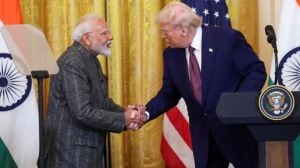Karmaveer Bhaurao Patil Marg: This road encompasses Telegraph Office, High Court
A Padma Bhushan recipient, Patil was also a prominent member of the Satyashodhak Samaj (Truth Seeker’s Society), which was founded by Phule.

The street was named after Paigonda Patil. (Express Photo/Ganesh Shirsekar)
(By Meenketan Jha)
The Karmaveer Bhaurao Patil Marg, which begins after breaking off from the Mahatma Gandhi Road at the Chaphekar Chowk and ends as it merges with the Madame Cama Road, was named after Paigonda Patil, better known as Karmaveer Bhaurao Patil. Running parallel to the Oval Maidan, the street encompasses several landmarks such as the Central Telegraph Office, Bombay High Court, and Mumbai City Civil and Sessions Court as well as the Rajabai Clock Tower.
Born in a tenacious Jain family on September 22, 1887 at Kumbhoj, in Kolhapur district of Maharashtra, Patil fought against the social ills that had plagued the society and impeded its secularist growth, all his life. An ardent follower of Mahatma Gandhi, he adopted the Khadi attire and followed Gandhian principles in everyday living.
An advocate of social equality, he worked to promote education among the backward communities of the state. In the process, he laid the foundations of the Rayat Shikshan Sanstha, which was established in the year 1919. “He had an incisive understanding of the social ills that beset his times and fully realised the dire need of the spread of education. He believed that education alone could correct the social ills such as caste-hierarchy, money-lending, illiteracy, untouchability, superstitions and social and economic inequality. Throughout his life, he tried to translate this belief into reality,” says an administrative official from the educational institution.
According to historian and former head of the history department at the Mumbai University, Arvind Ganacharya, Patil was heavily influenced by Chhatrapati Shahu Maharaj, the Maharaja of Kolhapur, who provided Patil with a place to stay and study. He admired the king’s fight for social equality and education of people belonging to backward castes. “Patil idolised Mahatma Jotirao Phule and Vitthal Ramji Shinde, both social reformers in pre-Independent India who fought to remove the practise of untouchability and the caste system, and sought to follow their footsteps,” adds Ganacharya.
A Padma Bhushan recipient, Patil was also a prominent member of the Satyashodhak Samaj (Truth Seeker’s Society), which was founded by Phule. “Paigonda Patil was bestowed the name Karmaveer, meaning a king of action, by the people of Maharashtra, who adored his will and dedication. He was man who believed in the power of action and not just words,” says Ganacharya.












